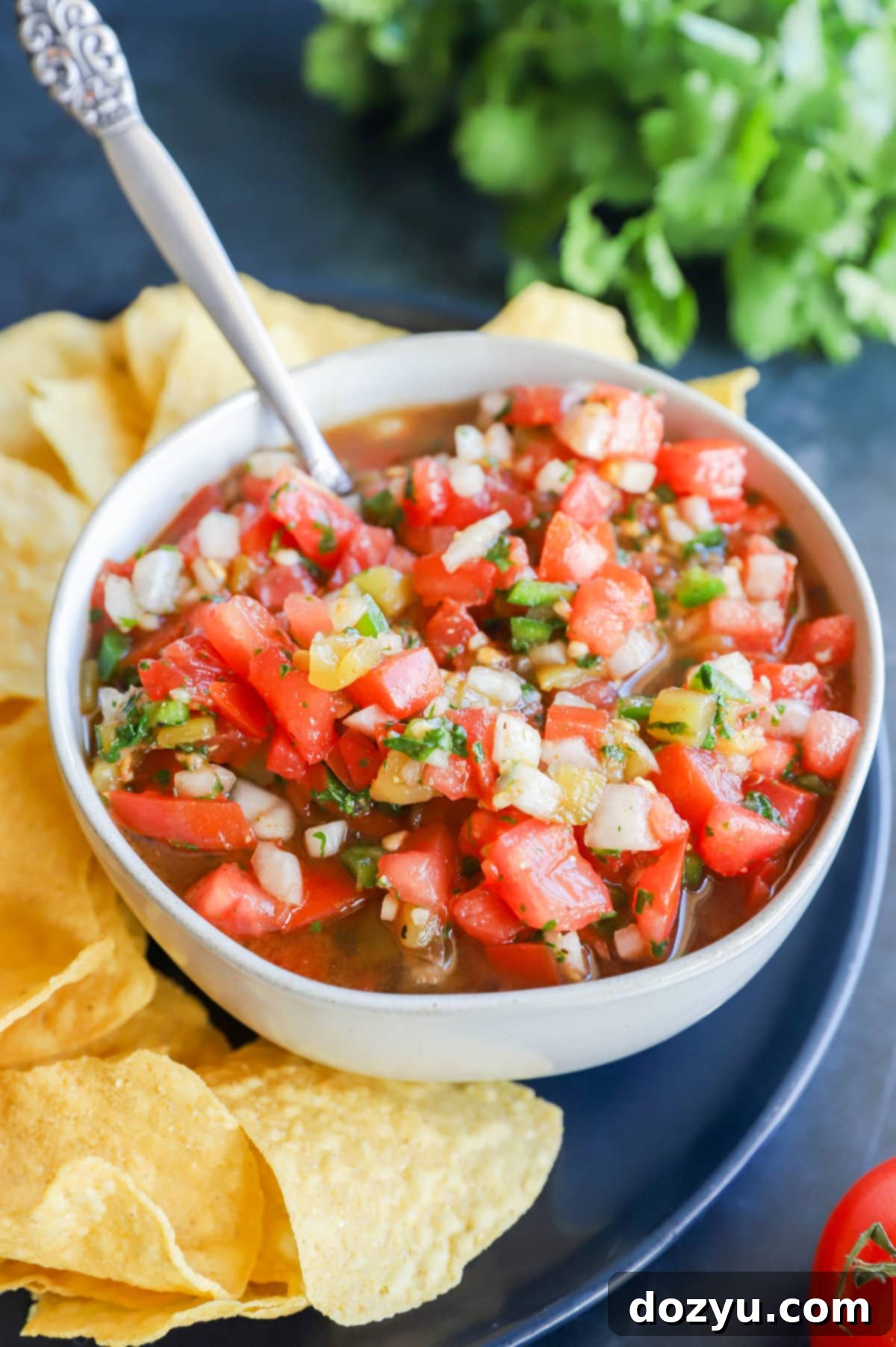The Ultimate Guide to Choosing the Best Tomatoes for Your Perfect Homemade Salsa
Get ready to elevate your salsa game to legendary status with our definitive guide to selecting the finest tomatoes! We’re diving deep into the world of tomatoes to reveal the juiciest, most flavorful varieties that will transform your homemade salsa. From achieving that perfect balance of natural sweetness and bright acidity to delivering an irresistible burst of garden-freshness, the right tomatoes are the secret ingredient that makes your salsa truly shine. Whether you’re a seasoned salsa maker or just starting out, understanding the nuances of different tomato types is key to crafting a dip that everyone will rave about.

table of contents
Toggle
The Best Tomatoes for Salsa
Crafting the perfect salsa undeniably begins with choosing the right tomatoes. While many varieties can contribute to a delicious salsa, the “best” choice truly hinges on the specific flavor profile and texture you aim to achieve. Whether you’re dreaming of a vibrant, chunky pico de gallo or a smooth, restaurant-style dip, the characteristics of your chosen tomato play a pivotal role.
Each tomato variety brings its own unique set of attributes to the table, from sweetness and acidity to juiciness and firmness. Understanding these differences allows you to tailor your salsa to your exact preferences. Some tomatoes offer a bold, rich flavor that stands out, while others provide a milder base, allowing other ingredients to shine. Ultimately, the freshest, ripest tomatoes, regardless of variety, will always yield the most exceptional flavor. This guide will walk you through our top recommendations, ensuring your tacos, tortilla chips, burritos, and more are always accompanied by the most exquisite homemade salsa.
In the following sections, we’ll delve into the specific advantages of various tomato types, offering insights into their ideal uses in salsa. We’ll also cover crucial tips for selecting ripe tomatoes, mastering fresh salsa techniques, and answering frequently asked questions about this beloved condiment. Experimentation is highly encouraged, as discovering your personal favorite tomato for salsa is part of the joy of cooking. Get ready to embark on a flavorful journey and savor salsa bursting with the vibrant essence of perfectly chosen tomatoes!
My personal culinary aspiration is to one day grow my own diverse array of tomato plants in a dedicated salsa garden. Imagine stepping outside, selecting perfectly ripe tomatoes straight from the vine each week, and transforming them into an unparalleled fresh salsa. The taste of garden-fresh tomatoes in homemade salsa is truly unmatched, a culinary dream worth pursuing.
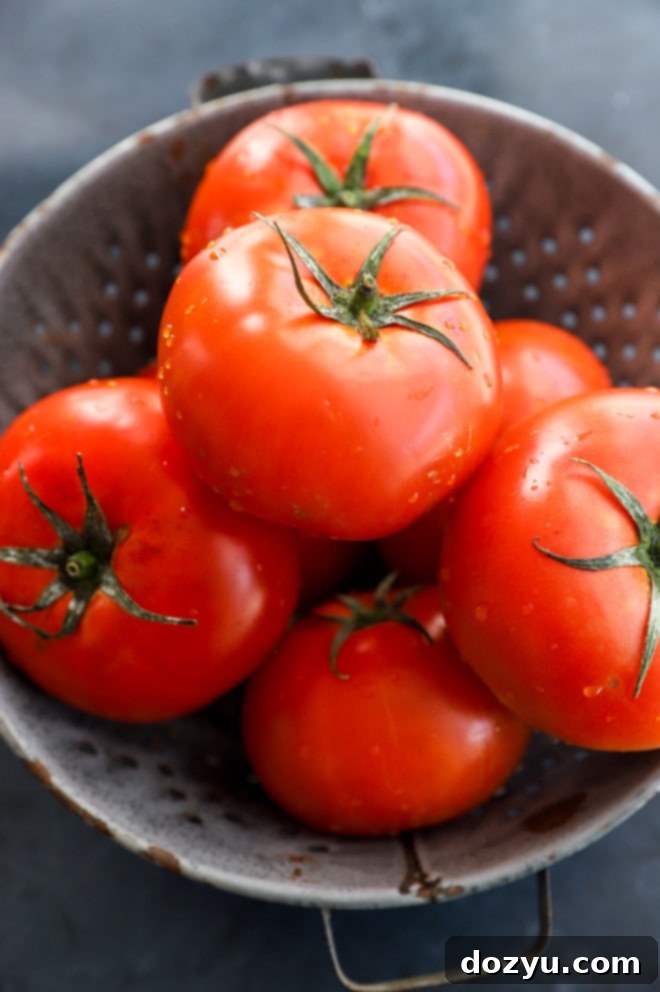

Everyday Seasonal: Summer Cookbook
Embrace the vibrant flavors of summer with our Everyday Seasonal cookbook! Filled with delightful seasonal recipes, a comprehensive produce guide, and expert tips, this cookbook is your essential companion for celebrating the best of summer’s bounty. Discover new ways to enjoy fresh ingredients and create memorable meals.
The Top Tomato Varieties for Salsa
With an abundance of tomato varieties available, choosing the perfect one for your salsa can seem daunting. Each type offers distinct characteristics that can significantly influence the final taste and texture of your homemade creation. Here are some of our absolute favorite tomatoes, ideal for crafting your next unforgettable salsa recipe, along with tips on how to identify their peak ripeness.
Roma Tomatoes
Roma tomatoes, often referred to as plum tomatoes, are quintessential for salsa. Their oblong shape, firm flesh, and vibrant deep red color make them instantly recognizable. What truly sets Romas apart for salsa is their low water content and minimal seeds, which helps prevent your salsa from becoming watery. They boast a mild, balanced tomato flavor with low acidity, making them incredibly versatile. This allows other salsa ingredients, like onions, chilies, and cilantro, to truly shine without being overpowered. Their firmness also makes them exceptionally easy to chop into uniform pieces, perfect for chunky salsas or pico de gallo.
There’s even a specialized hybrid known as a “fresh salsa tomato,” specifically bred for its ideal salsa characteristics, further cementing the Roma’s reputation.
How to know when a Roma tomato is ripe: A perfectly ripe Roma tomato will have a firm, smooth skin that yields slightly to gentle pressure. It should exhibit an even, deep red color all over, with no green patches at the stem end, and feel heavy for its size. Avoid any tomatoes with soft spots or blemishes.
Beefsteak Tomatoes
While often celebrated for sandwiches and burgers, large, round, and intensely red beefsteak tomatoes are also a fantastic choice for homemade salsa. They offer a slightly higher acidity than Romas, coupled with a delightful sweetness, creating a complex and robust tomato flavor. Their substantial size and fleshy interior make them incredibly easy to dice, yielding generous chunks that contribute a satisfyingly hearty texture to your salsa. Beefsteaks are true all-purpose tomatoes, providing a juicy, bold essence that speaks of summer gardens. They are my personal favorite for their vibrant flavor contribution.
How to know when a Beefsteak tomato is ripe: Look for a medium to deep red hue, free from green shoulders. The tomato should feel firm but have a noticeable “give” when gently squeezed, indicating juiciness without being mushy. Inspect for any cracks in the skin or bruised areas.
Cherry Tomatoes
These delightful small, round tomatoes are packed with concentrated sweetness, making them excellent for brightening up salsas. Cherry tomatoes are particularly wonderful for sweeter salsas, perhaps those incorporating fruits like mango or pineapple. Their small size means you can halve or quarter them easily, adding visual appeal with minimal effort. They also contain fewer seeds and less water than many larger varieties, which helps maintain a desirable salsa consistency. Don’t limit yourself to red; cherry tomatoes come in a rainbow of colors—yellow, orange, and even purple—allowing for truly vibrant and fun salsa creations, especially when combined with other tomato types.
How to know when cherry tomatoes are ripe: Since cherry tomatoes are often sold in pre-packaged containers, it’s crucial to inspect the entire package for any signs of mold, shriveling, or excessively soft tomatoes. Ripe cherry tomatoes should be plump, firm, and brightly colored. Avoid any that feel mushy or have wrinkled skins.
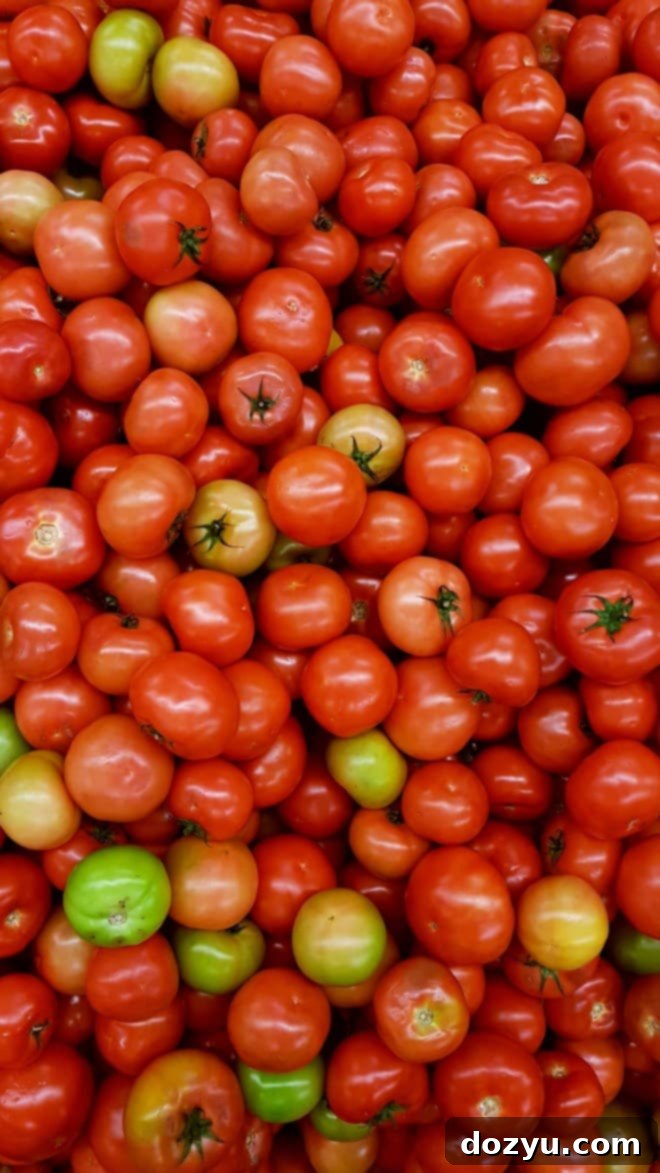
Plum Tomatoes
Plum tomatoes, a category that includes Romas, are characterized by their distinctive oblong shape and rich red color. While similar to Roma tomatoes, many plum varieties often offer a more pronounced balance of acidity and sweetness, contributing a bolder flavor profile to your salsa. Their firm, meaty texture and relatively low water content make them an excellent choice for achieving a thick, substantial salsa, particularly ideal for those aiming for a restaurant-style consistency that adheres well to a chip. Given these attributes, it’s no surprise that plum tomatoes are frequently specified in traditional salsa recipes, and many consider them among the absolute best for this purpose, a sentiment I largely share, only rivaled by my affection for beefsteaks.
How to know when a Plum tomato is ripe: A ripe plum tomato should display an even, deep red color without any lingering green patches, especially around the stem. The flesh should feel firm but not hard, offering a slight give when gently pressed. Always check for any signs of bruising or soft spots, which indicate overripeness or damage.
Heirloom Tomatoes
Heirloom tomatoes are a celebration of diversity, coming in a spectacular array of unique shapes, sizes, and colors, each offering its own distinctive and often complex flavor profile. Their deep, rich, and intensely “tomatoey” taste makes them an incredibly exciting option for elevating your salsa, especially during the peak summer months when they are readily available at farmers’ markets. Using heirlooms can transform a simple salsa into a gourmet experience, adding layers of flavor that can range from sweet and fruity to smoky and earthy. Look for ones with vibrant colors and smooth, unblemished skins to ensure the highest quality and best flavor for your culinary creations.
How to know when a Heirloom tomato is ripe: The most reliable indicator for heirloom ripeness is often the color on the bottom of the tomato; the darker and more saturated it is, the riper the fruit. Red varieties will deepen to a rich crimson, yellow ones to a vibrant gold, and green heirlooms will exhibit a deep, uniform green hue. When gently squeezed, a ripe heirloom should offer a slight, subtle give, indicating perfect juiciness and tenderness without being overly soft.
Honorable Mentions
- San Marzano – While primarily famous for their use in exquisite Italian sauces, San Marzano tomatoes possess characteristics that make them surprisingly wonderful for salsa. They are renowned for their fewer seeds and lower water content compared to many other varieties, offering a meaty texture. Their naturally sweet flavor profile can add a delightful richness to your salsa, particularly if you enjoy a touch of sweetness.
- Little Mama/Big Mama – These are specific varieties of plum tomatoes, celebrated for their exceptionally firm flesh and excellent, robust flavor. If Roma or general plum tomatoes are unavailable, these “Mama” varieties are superb substitutes, guaranteeing a salsa with great body and taste.
- Grape Tomatoes – Similar to cherry tomatoes but typically more oblong, grape tomatoes also offer concentrated sweetness and low water content. They are perfect for quickly adding a burst of flavor to fresh salsas and can be used interchangeably with cherry tomatoes.
So, which tomato variety will you choose for your next homemade salsa masterpiece?
Homemade Salsa Must-Haves: Essential Kitchen Tools
Equipping your kitchen with the right tools can make all the difference in preparing delicious homemade salsa quickly and efficiently. These are some of our top recommendations:
mixing bowls
Buy Now →
chef’s knife
Buy Now →
cutting board
Buy Now →
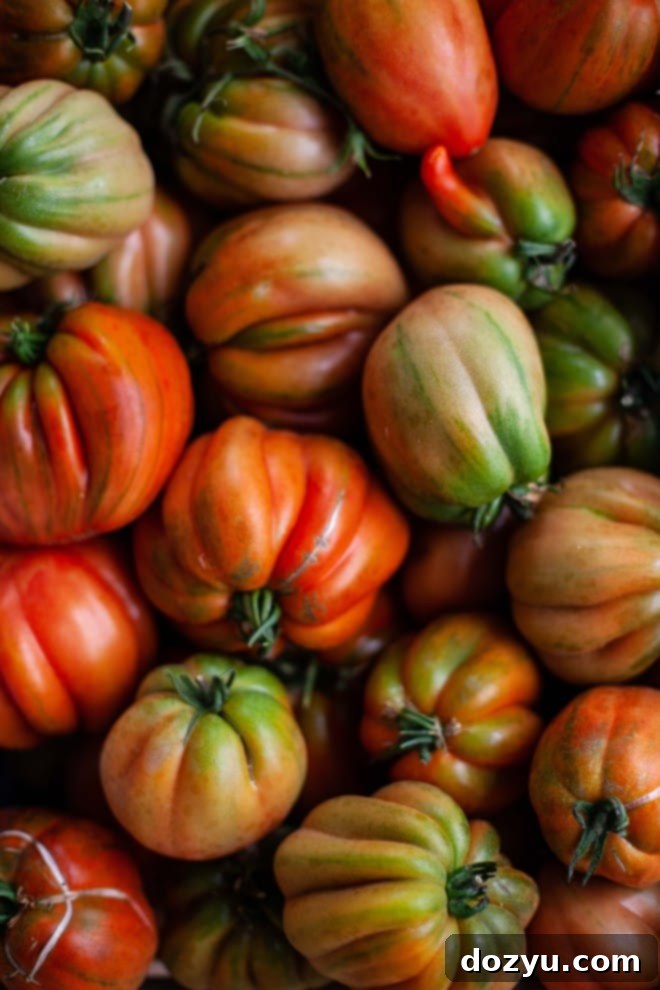
Selecting the Right Tomatoes for Your Salsa Recipe
Beyond simply picking a favorite type, understanding a few key characteristics of tomatoes will significantly impact the flavor and texture of your final salsa. Considering acidity, sweetness, and texture allows you to fine-tune your recipe to perfection.
Acidity
Tomato acidity is a crucial component that can either brighten or mellow your salsa’s overall taste. A higher acid content provides a zesty, tangy kick that cuts through richness and adds vibrancy, often desired in a classic pico de gallo. Tomatoes like Beefsteaks or some varieties of Heirloom tomatoes tend to have a higher acidity. If you prefer a milder, more mellow salsa, opt for lower-acid varieties such as Roma tomatoes, which offer a softer, more rounded flavor. The acidity also works in harmony with other acidic ingredients like lime juice, so choose wisely to strike your preferred balance.
Sweetness
The inherent sweetness of a tomato can dramatically alter your salsa’s character. Sweeter tomatoes provide a delightful contrast to spicy peppers and tangy lime, creating a well-rounded flavor profile. Cherry and grape tomatoes, for instance, are naturally sweeter and burst with concentrated sugars, making them ideal for fruit-based salsas (like mango or peach salsa) or for balancing out very hot chilies. If your recipe already includes sweet components, a less sweet tomato might be preferred to avoid an overly saccharine result. Conversely, if you’re aiming for a fresh, vibrant, and approachable salsa, a naturally sweet tomato can be your best friend.
Texture
The texture of your chosen tomato directly dictates the consistency of your salsa. Fleshy, firm tomatoes with low water content, such as Roma or plum tomatoes, are excellent for creating chunky salsas or pico de gallo where distinct pieces of tomato are desired. These varieties hold their shape well when diced and contribute to a thick, robust dip. Softer, juicier tomatoes like Beefsteaks, while offering great flavor, might result in a more liquid salsa if not properly seeded and drained. For a smooth, restaurant-style salsa, the initial texture is less critical since everything will be blended, but using meatier tomatoes can still contribute to a thicker final product, even after processing.
How to Make Fresh Tomato Salsa
While I have a particular fondness for chunky salsa, the core principles for making any fresh tomato salsa remain the same. The absolute number one rule for exceptional salsa is to prioritize the freshest, highest-quality ingredients you can find. This commitment to fresh produce will always guarantee the best possible flavor outcome. Here’s a breakdown of the essential components that form the foundation of any great salsa recipe:
- Tomatoes: As we’ve extensively discussed, the type of tomato you choose is paramount. Select varieties that align with your desired flavor, sweetness, acidity, and texture. Ripe, fresh tomatoes are non-negotiable for vibrant, flavorful salsa.
- Aromatics: These ingredients build the foundational flavor of your salsa. Onion (white, yellow, red, or green onions/scallions) and garlic are typical additions. For a milder flavor, use white or green onions; for a sharper bite, red onion is excellent. You can use raw garlic for a pungent kick or roasted garlic for a sweeter, mellower undertone. While garlic is highly recommended, if you don’t have it on hand, your salsa can still be delicious.
- Chilies: This is where the spice and heat come in! Jalapeños are a common choice, offering a moderate heat, but you can adjust based on your preference. For more heat, consider serrano peppers; for a smoky flavor, chipotles in adobo work wonders; and for extreme heat, habaneros or scotch bonnets. Remember that removing seeds and membranes can reduce the heat. Roasting or charring chilies before adding them can also impart a deeper, smoky dimension.
- Fresh Herbs: Cilantro is the classic herb for salsa, providing a bright, refreshing, and slightly citrusy note that is indispensable for many. However, if cilantro isn’t to your taste (due to the genetic predisposition for some to find it soapy), fresh oregano or even a hint of fresh basil can offer interesting and delicious alternatives.
- Acid: A touch of acid is vital for brightening the flavors and balancing the richness of the tomatoes and the heat of the chilies. Freshly squeezed lime juice is the go-to, offering a zesty, refreshing quality. Alternatively, a good quality white wine vinegar or even a splash of apple cider vinegar can be used.
- Spices: While salt and pepper are fundamental for seasoning, a few additional spices can deepen the complexity of your salsa. Ground cumin adds a warm, earthy flavor, while chili powder can enhance the savory notes. A pinch of smoked paprika can introduce a subtle smokiness, and a tiny bit of sugar can sometimes help balance overly acidic tomatoes. Taste as you go and adjust to your liking!
Our favorite unique recipes that feature salsa: BBQ Glazed Grilled Bratwurst with Spicy Peach Salsa | Whipped Goat Cheese Salsa Dip | Salsa Jalapeño Crunch Burger | Salsa Verde Chorizo Pizza
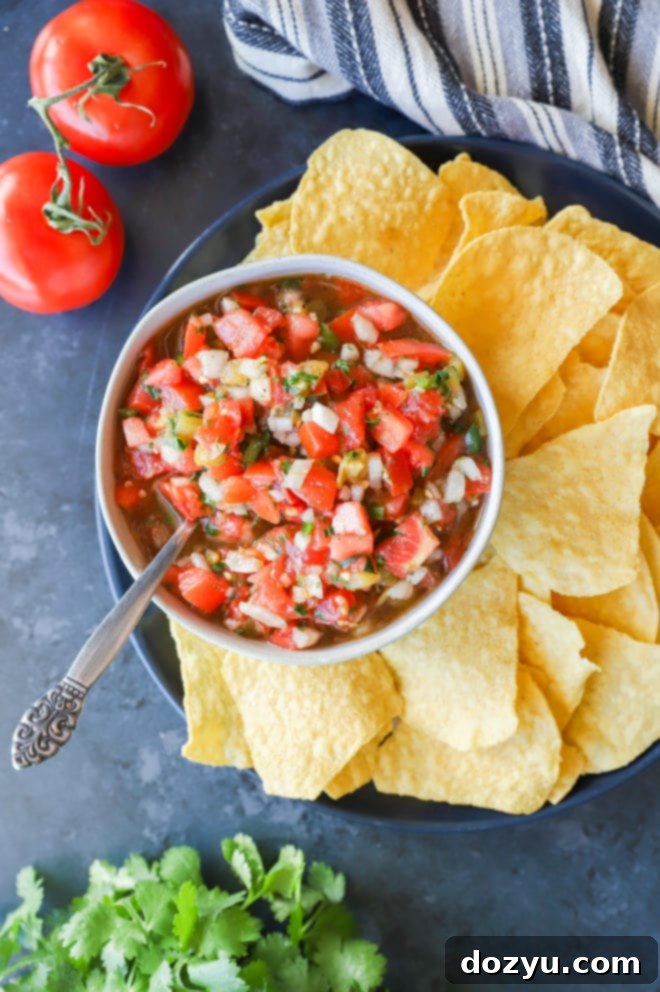
Can You Use Canned Tomatoes for Salsa?
Absolutely, yes! Canned tomatoes are a perfectly viable and often excellent option for making salsa, especially when fresh, in-season tomatoes are unavailable. They are particularly well-suited for creating restaurant-style salsas, which often rely on a smoother, more uniform texture. Canned tomatoes offer convenience and consistent flavor year-round.
When using canned tomatoes, consider these types: diced tomatoes (for a chunkier texture), crushed tomatoes (for a smoother base), or even whole peeled tomatoes that you can crush yourself. Fire-roasted canned tomatoes are a fantastic choice, as they impart a smoky depth of flavor that can elevate your salsa without requiring any extra effort. Just be mindful of their liquid content; you might need to drain them partially to achieve your desired consistency. While canned tomatoes are a great pantry staple, I always recommend opting for fresh tomatoes whenever they are in peak season for that unparalleled burst of vibrant, natural flavor.
What is a Good Fresh Salsa Recipe?
My unwavering preference is for chunky salsa! This is undeniably my favorite fresh salsa recipe, especially when tomatoes are in their prime season. It embodies everything a homemade salsa should be: vibrant, full of texture, and bursting with garden-fresh flavor. This recipe is incredibly versatile; if you prefer a smoother consistency, simply pulse it a few times in a food processor to achieve that desired restaurant-style blend.
This chunky salsa is fantastic when piled high on shredded beef tacos, enhancing every bite with its refreshing tang and subtle heat. It’s also an absolute must-have for any taco bar party, where its fresh flavors are guaranteed to be a crowd-pleaser and have everyone digging in for more. Its simple yet impactful ingredients allow the natural deliciousness of the fresh tomatoes and other produce to truly shine, making it the best homemade salsa for virtually any occasion.
What Are the Best Tomatoes for Chunky Salsa or Pico de Gallo?
For a truly satisfying chunky salsa or pico de gallo, the key lies in selecting tomatoes that are meaty, firm, and have a relatively low water content. You want tomatoes that will hold their shape when diced and contribute substance rather than excessive liquid. Beefsteak tomatoes are an excellent choice due to their large size, robust flavor, and solid flesh, which makes them very easy to chop into substantial chunks. Other “slicing” tomatoes, such as various heirloom varieties, are also ideal because of their unique, deep flavors and often firm textures.
Roma tomatoes and plum tomatoes are also highly recommended for chunky salsas. Their oblong shape, firm walls, and minimal seeds and juice ensure that your salsa remains thick and full of distinct tomato pieces. These varieties prevent your salsa from becoming too watery, allowing for that perfect scoopable texture that makes chunky salsa so enjoyable. The ease with which these tomatoes can be diced also contributes to their popularity for this style of salsa.

What Are the Best Tomatoes for Restaurant-Style Salsa?
When crafting a smooth, dip-like restaurant-style salsa, your tomato choices open up considerably. Since all the ingredients will be blended to a uniform consistency, the amount of water or seeds in a particular tomato type becomes less of a critical factor. This means you can confidently use virtually any type of fresh tomato available. Juicier varieties, which might make a chunky salsa watery, work perfectly here as their liquid contributes to the smooth texture. Even canned tomatoes, as discussed earlier, are an excellent and popular choice for restaurant-style salsa, offering consistent flavor and ease of preparation.
However, to achieve a thicker, more viscous smooth salsa, opting for meatier, less watery tomatoes like Roma or plum tomatoes can still be beneficial. Their higher flesh-to-liquid ratio will naturally contribute to a denser consistency after blending. Additionally, incorporating fire-roasted tomatoes, whether fresh or canned, can add a wonderful depth and smoky complexity that is a hallmark of many authentic restaurant salsas. Don’t hesitate to experiment with different combinations to find your perfect blend!
What Are Paste Tomatoes?
Paste tomatoes are a specific category of tomato highly prized for their robust culinary characteristics, especially for making sauces, pastes, and, naturally, salsa. They go by several names, including Amish paste tomato, Roma tomato, and various types of plum tomatoes. While each of these might have slight individual differences, they all share common traits that make them ideal for cooking applications.
The defining features of paste tomatoes include their relatively small size, typically oblong or pear shape, and their thick, meaty flesh. They are characterized by a low water content and minimal seeds, which is why they are so excellent for salsa. These qualities make them incredibly easy to dice, slice, chop, and even peel, resulting in a dense, flavorful product without excess liquid. Their firm structure helps them hold up well during cooking or blending, contributing to a rich texture in any recipe.
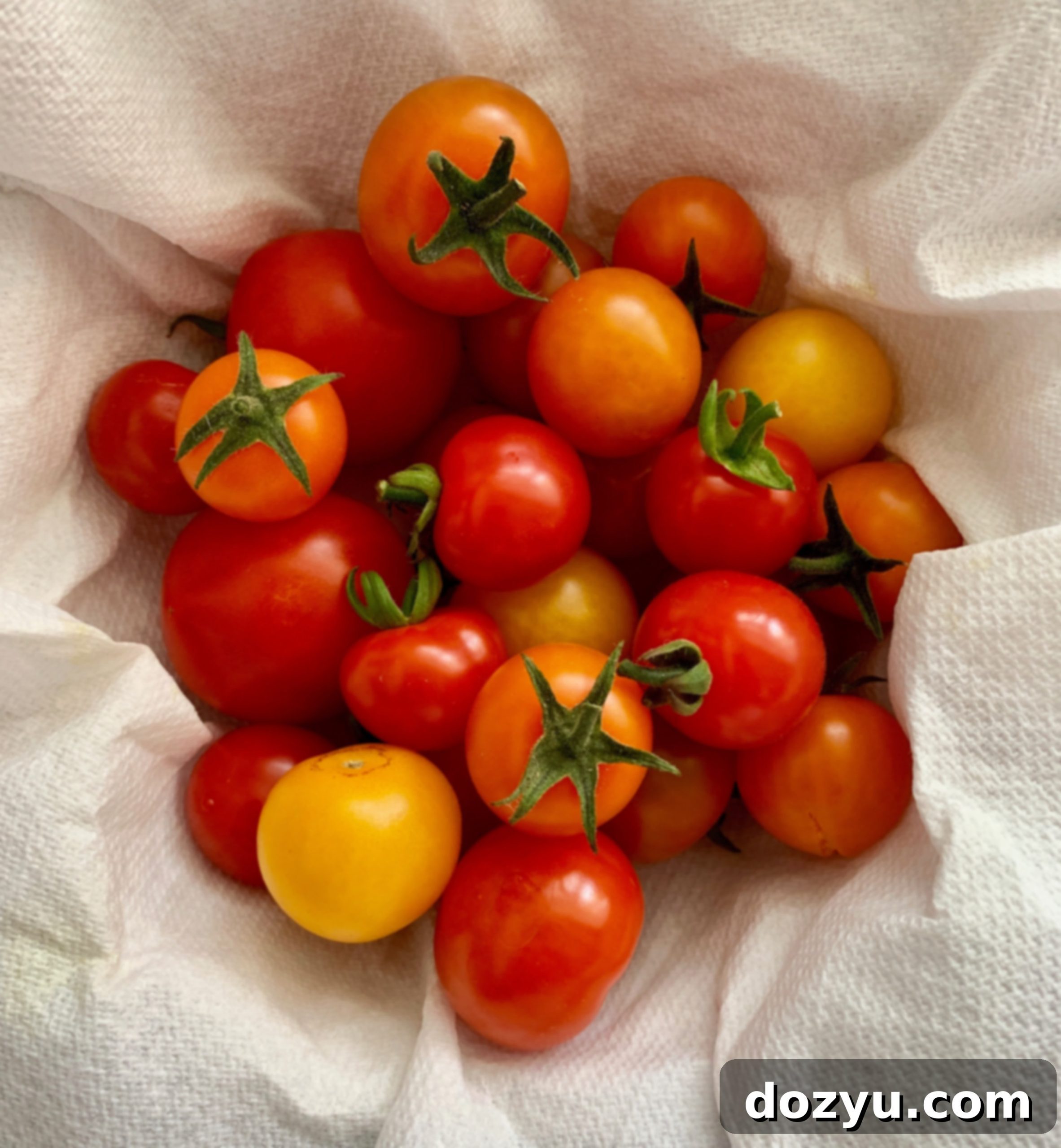
I Don’t Have Any of These Tomatoes on Hand, But I Really Want to Make Salsa…
Don’t despair! When the craving for fresh salsa strikes, the best variety of tomato for the job is often simply the one you already have. In all seriousness, almost any fresh tomato can be transformed into a delicious salsa, even if it’s not on our “top picks” list. The beauty of homemade salsa lies in its adaptability and your ability to work with what’s available.
If you find yourself with a large, particularly juicy or seedy tomato that isn’t typically recommended for salsa, there’s an easy fix. I highly recommend taking a few extra minutes to remove the seeds and excess watery pulp. Here’s a simple method:
- Start by slicing off the top (stem end) of the tomato.
- Turn the tomato cut-side down on your cutting board.
- Slice the tomato into quarters.
- Working with one quarter at a time, use a small knife or spoon to carefully follow the curve of the tomato, separating the seeds and watery core from the firm outer flesh. Discard the seedy pulp.
- Once deseeded, you’ll be left with meaty pieces of tomato flesh, which you can then dice up for your salsa.
This technique significantly reduces the water content, ensuring your salsa has a better, thicker consistency. Additionally, if your chosen tomato is particularly watery, consider letting your diced tomatoes sit in a colander for 10-15 minutes to drain off any excess liquid before mixing them into your salsa. With these simple adjustments, you can make a fantastic fresh salsa with almost any tomato variety, ensuring your craving is satisfied!
Everyday Seasonal Cookbook
Unlock the full potential of seasonal cooking with our Everyday Seasonal Cookbook. Packed with inspiring recipes, comprehensive produce guides, and invaluable culinary tips, this cookbook is your ultimate resource for creating delicious, seasonal meals for every occasion. Discover new flavors and make the most of fresh ingredients all year round.
We sincerely hope this comprehensive guide to selecting the best tomatoes for salsa has been incredibly helpful! Crafting homemade salsa is a wonderfully rewarding experience, and the right tomato truly makes all the difference. We encourage you to experiment with different varieties, trust your palate, and discover which tomatoes create your perfect blend.
If you found this guide valuable, please consider sharing it with fellow food enthusiasts or leaving a comment below to share your favorite tomato for salsa! Your feedback and questions are always welcome, and I make an effort to respond to every single comment.
And of course, if you make any of the delicious salsa recipes mentioned or inspired by this post, don’t forget to tag me on Instagram! Seeing your culinary creations come to life in your homes is one of my greatest joys and truly means the world to me. Happy salsa making!
